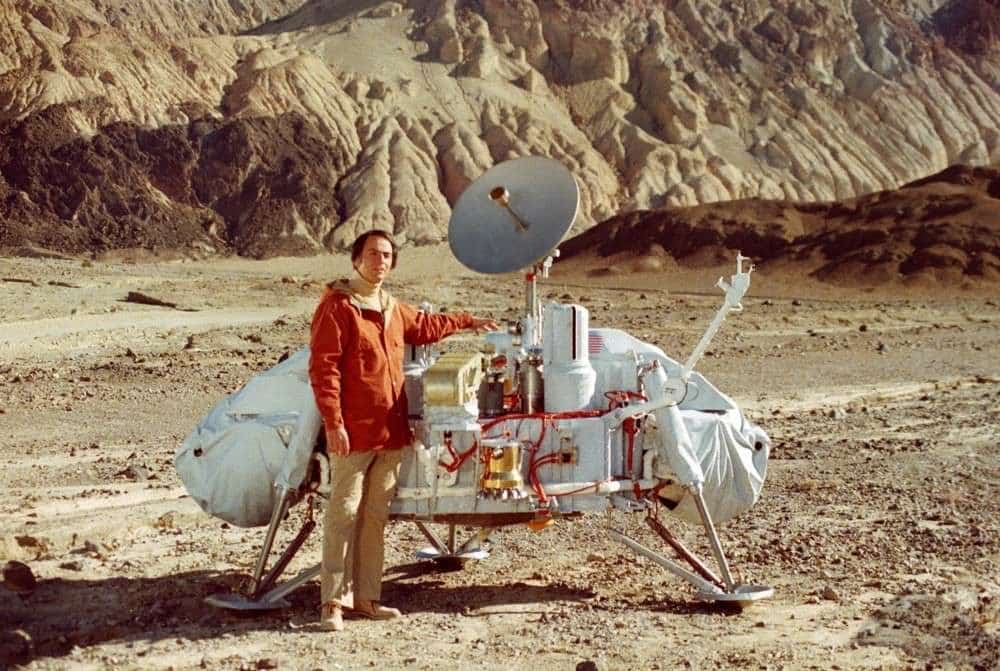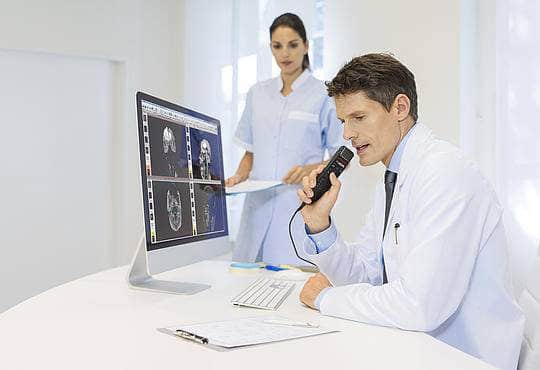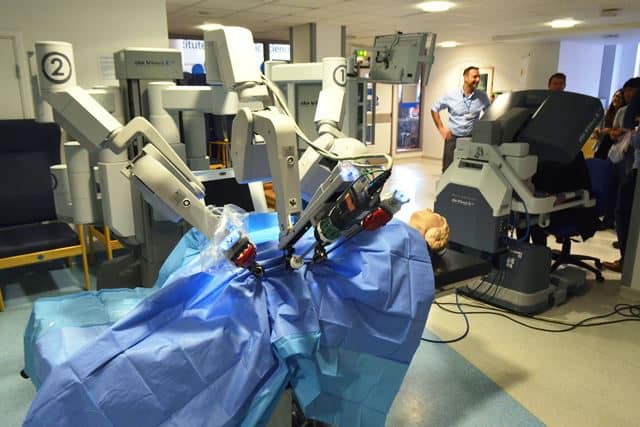Surgical robots that don't shake, blind people who see again, longer life expectancy, cancers detected before the first symptoms appear... new technologies are performing miracles that were unimaginable just a few years ago. Between AI, machine learningFrom artificial intelligence to robotics and implants, medtech is improving patient health and saving lives. Trainer and expert in artificial intelligence and robotics, Cédric Vasseur takes the pulse of medicine 3.0 and answers our questions.

Health is one of the areas where artificial intelligence is expected to make the greatest advances. Artificial intelligence took off in the 2010s, thanks in particular to advances in deep learning which imitatesmachine learningthe learning method used by human beings to acquire certain types of knowledge. It all began above our heads, in space.
Could the conquest of space be behind the medical innovations of recent years?
Exactly! Like other sectors, medicine is keeping pace with scientific progress. Artificial hearts, insulin pumps and MRI (Magnetic Resonance Imaging) are now commonplace. And yet these innovations were born out of the conquest of space.
The ventricular pump used in artificial hearts is derived from the fuel pumps used on the US space shuttle in the early 2000s. The first French artificial heart was co-developed by engineers from EADS and Matra in 2008. As for MRI, although it was not invented by NASA, it was greatly improved by its engineers who needed to enlarge photos of the Moon!
Similarly, the insulin pumps were inspired by the robotic arm of the Viking probe launched in 1975. And dialysis machines are an improvement on the fluid recycling systems of the Apollo missions. Robotics and artificial intelligence are simply following in this illustrious footsteps.

What does AI bring to the healthcare sector?
Medical imaging is the first to benefit from advances in artificial intelligence. Artificial intelligence has been added to MRI machines and scanners to improve image quality and facilitate diagnosis. MRI scanners are extremely expensive, costing over a million euros for the latest generation models. As a result, some companies are selling AI-based software solutions to update older MRI machines and improve their image quality, without the hospital needing to invest in a new machine.
As well as improving image quality, AI will facilitate diagnosis. A radiologist may miss an anomaly, either because he cannot see it with the naked eye, or because he is tired after analysing thousands of images during the day. The machine, on the other hand, does not tire. According to a study published in 2018 in the prestigious journal Radiology, up to 25 % of cancers visible on a mammogram go undetected because of fatigue and lack of concentration. This is a worrying figure, especially as the amount of health data to be analysed is increasing exponentially: a radiologist sees up to 50,000 images per day, 40 times more than thirty years ago!
How does AI work? It uses machine learning The machine is fed thousands of X-rays to train it to detect anomalies autonomously. A PET scan is now capable of detecting the presence of metastases instantly and automatically. The technology is so effective that radiologists are in danger of being gradually replaced by these machines.
Does artificial intelligence help doctors in other ways?
Yes, artificial intelligence has even advanced knowledge of radiology. In 2017, IBM created Watson, an artificial intelligence capable of analysing different types of cancer. After seeing thousands of X-ray images, the AI made doctors understand that the edge of the usual analysis zone of an image contained important information, such as the centre of the tumour.
AI is being used to improve access to knowledge. Doctors all over the world share their information on which molecule to take for a given symptom or illness. Just imagine the amount of information to be processed: thousands and thousands of pages a day of studies and epidemiological reports. It's a job that no human being, no matter how expert, can assimilate. Recognised as an expert in oncology, IBM's Watson is fed day after day with articles from medical journals, biopsy results, laboratory tests, comparisons of molecules, etc. When asked about a treatment, Watson will change its recommendation according to its latest updates, and will recommend molecule Z rather than B.
Less impressive, but very useful to doctors, AI is used every day by doctors to type up medical reports. Before, we had an army of secretaries typing up reports dictated by doctors. Today, Nuance, through its flagship product Dragon Naturally Speaking, enables doctors to use speech recognition based on deep learning and machine learning to transcribe their medical reports.

Can AI diagnose diseases before the first symptoms appear?
Yes, for example, IBM's Watson can predict the onset of breast cancer a year before it occurs. Other AIs are used for epidemiological predictions. For example, we can track the spread of influenza using algorithms that scan social networks for people complaining about its symptoms.
Using the same type of technique, an AI from the Canadian company BlueBot detected the emergence of the pandemic on 31 December 2019, when it was considered to be an epidemic of pneumonia confined to Wuhan, China. It used around a hundred sets of data from the Internet (news websites, airline ticket sales, demographic, climate and animal population data, etc.) to determine the threat, its geographical location and its spread, providing a list of cities likely to be affected in turn.
What do robots bring to medicine?
AI is not alone in its contribution to medicine. Surgical robots are considerably improving the precision of surgical operations. The most famous is the American Da Vinci. This robot is equipped with a wide range of instruments (forceps, scalpels, cameras, etc.) that can be manipulated remotely by a surgeon present in the operating theatre.
AI improves robots by automating certain procedures and improving working conditions for surgeons. When an operation goes wrong and blood covers what the surgeon is doing, the machine can continue stitching by itself.
The precision of these surgical robots is so great that their manufacturers have demonstrated that they can perform stitches on grapes without bursting them.
Other robots, still under development, are capable of automatically inserting a catheter. This is a very complicated procedure, usually involving a nurse who knows how to detect veins.

What about implants?
When it comes to implants, current technologies are reminiscent of science fiction films or miracles: the profoundly deaf can hear, the blind can see.
Let's take the example of deaf people. They are surgically implanted with a cochlear implant, a set of small electrodes that deliver tiny electrical impulses to the cochlea. After the operation, they can hear, although not like you and me. They have to go through a re-education phase and they will not be able to detect music easily. In the 90s, people with cochlear implants had to wear a device the size of a Walkman around their waist, with a cable running up under the flesh. Today, cochlear implants work by induction. An antenna is placed under the skin. A magnetised outer part contains the electronics and is placed above the skin. You remove this mini-casing and the person is deaf again. We can now place the implant directly on the nerve, or even implant electrodes directly into the brain. And it works!
Second Sight also uses implants for vision. For the moment, only a few pixels appear in people's eyes. These few pixels enable them to become more autonomous, as they can move around in the street, see signs and pavements and grasp objects.
Will AI and robots be applied to everything?
No. Some areas of medicine are too complex for AI and robots. For example, in orthopaedic surgery, we tested a robot to operate on a foot. The machine made too many mistakes and was withdrawn from the market. What's more, certain procedures cannot be automated. All the medical and personal assistance professions that require psychology, imagination, communication skills and empathy are likely to remain in the hands of humans.
This does not mean, however, that these professions will not one day be assisted in whole or in part by robotics or other forms of new technology: robotic surgeons, robotic draughtsmen, 'intelligent' decision-making tools, etc.
What are the underlying problems?
These technologies inspire both dreams and fear. Fear that the machine alone will make the decisions, fear of its dehumanising side. Yet in medicine, many analyses are already fully automated, such as PCR tests and blood samples. Nevertheless, human beings still have their place when samples are taken.
Robots can even improve the lot of some people, such as dependent elderly people, by giving them greater autonomy over their own grooming. These people are less embarrassed to have to deal with a machine.
The other limitation encountered by these technologies is in terms of data. AI requires large quantities of data, and high quality data at that. This also raises the issue of data collection, individual consent and the secure storage of data. sensitive data.
To qualify the quality of data, we need to take into account the differences between the machines that collect it. In medical imaging, for example, the quality of X-rays and MRIs will vary depending on the equipment. As far as confidentiality is concerned, data collection does not pose a problem in hospitals, as it is doctors who collect the data, thus avoiding any confidentiality concerns.
The question of anonymisation is just as important. If you are given a radio, it is difficult to make it completely anonymous. In the United States, students managed to find a governor's radio stations in a public database. Using AI, they cross-referenced these X-rays with the age of the governor in question and managed to determine in which hospital the X-rays were taken. In France, all sensitive medical data must be stored in data centres secure, EDS-certified health data warehouses.
What does the future hold for AI and robots in medicine?
These technologies will continue to improve and become more widely available. Their benefits are manifold:
- Making up for the shortage of medical staff. We can imagine the installation of terminals at hospital entrances that will direct patients according to their symptoms. Or teleconsultation booths will multiply and provide regular care or monitoring (hypertension, for example), thus combating medical deserts.
- Win time. Robots will be able to perform more surgical procedures, such as automatically inserting catheters, thereby saving precious time for medical teams. Robots will become more autonomous during operations, with gestures that are more precise than those of a surgeon. Thanks to AI, voice recognition is already making it easier to enter medical reports and patient data via terminals and tablets. Contactless interfaces are set to develop, with voice-activated functions and medical records appearing in the doctor's augmented reality glasses.
- Personalize treatments. Thanks to AI, treatments will be much more finely tailored to each patient. Our digital medical records will follow us throughout our lives.


